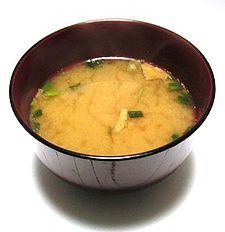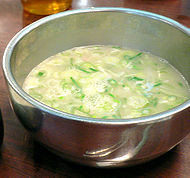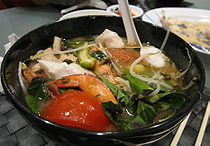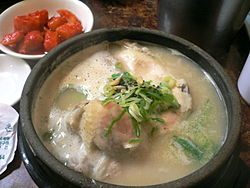- Asian soups
-
Asian soups are soups traditionally prepared and consumed in the cultures of East Asia. Such soups are usually based solely on broths and lacking in dairy products such as milk or cream. Thickening for the soups usually consists of refined starches from corn or sweet potatoes.
Asian soups are generally categorized as either savoury or sweet. The quality of a savoury soup is determined mainly by its fragrance and umami or "xian" flavor, as well as, to a lesser extent, its mouthfeel. Sweet soups such as tong sui are enjoyed for their aroma, mouthfeel, and aftertaste. Many soups are eaten and drunk as much for their flavour as for their health benefits and touted for their purported revitalizing or invigorating effects.
Contents
Traditional soup bases
Since many Asian soups are eaten as one of the main dishes in a meal or in some cases served straight with little adornment, particular attention is paid to the soups' stocks. In the case of some soups, the stock ingredients become part of the soup.
Chinese
There are three basic traditional soup stocks in Chinese cuisine:
- Superior broth/stock (T: 上湯, S: 上汤): A dark tan broth made from Jinhua ham and chicken. This rich and umami broth is used in the creation of many expensive soups such as shark fin soup or wonton soup.
- Chicken (T: 雞湯, S: 鸡汤): The basic broth used in creating most Chinese soups. The basic broth is sometimes fortified with licorice root, wolfberry, and other Chinese herbs.
- Pork broth (T: 瘦肉湯, S: 瘦肉汤): Lean pork is used most often as the soup base for long-simmered Chinese soups, called 老火湯 in Cantonese. This soup base is often simmered over low heat for several hours with other roots, dried herbs, vegetables, and edible fungi like shiitake mushroom, white fungus, or wood ear[1]. The Cantonese are especially known for their long-simmered Chinese soups, as they often pair ingredients under Chinese Medicine concepts to enhance health-benefiting functions of the soup.
- White broth (T: 白湯, S: 白汤): Made from lightly blanched pork bones that have been vigorously boiled for several hours, creating a white milky broth. This broth has a rich mouthfeel, and is often used in ramen soups.
- Fish broth (T: 魚湯, S: 鱼汤): Made from fish that have been fried and boiled for several hours, creating a white milky broth. This broth has a rich mouthfeel, and sweet umami taste.
Ingredients used in making Chinese stocks can be recooked again to produce a thinner broth with less intense flavours, known as ertang(二湯, Pinyin:èr tāng, lit. second soup).
Japanese
Main article: DashiCollectively known as dashi, most Japanese soup bases are flavored primarily with kombu (kelp) and shavings from dried skipjack tuna (katsuobushi). They are soaked or simmered to release the umami flavours of the shavings, and the resulting broth is strained. Mirin is occasionally added to the broth to further enhance the taste of the broth.
- Kelp: Kelp (kombu) is soaked in lukewarm water or simmered to yield a light broth.
- Niboshi: made by soaking or boiling dried sardines (niboshi) in water. The heads and entrails are usually pinched off prior to soaking, to prevent bitterness.
- Shiitake dashi: made by soaking dried shiitake mushrooms in water.
Korean
- Seolleongtang (설렁탕) is a milky white thin soup made from slowly boiled oxtail and bones. It is believed to have restorative qualities.
- Galbitang (갈비탕) is made from boiled beef ribs (갈비).
Soups
The soup bases are used to cook a large variety of soups
American Chinese cuisine
In American-Chinese restaurants some of the most popular soups are: egg drop soup, hot and sour soup, wonton soup, and chicken with corn soup.
Korean
- Yukgaejang (육계장) is a spicy red soup made with beef strips, red pepper, and assorted vegetables (usually green and white onions, bean sprouts, among others); many variations include egg and rice or cellophane noodles dropped into the soup, and sometimes shrimp and other pieces of seafood. Of the spicy Korean soups, 육계장 is very popular among both Koreans and non-Koreans.
- Miyeok guk (미역국) is a soup made from boiled sliced beef and miyeok (popularized as wakame in Japanese). It is believed to be good for the blood vessels and heart. Koreans traditionally eat this for birthday celebrations, or when a woman gives birth to a child.
- Tteok guk (떡국) is a soup made with slices of rice cake. The base is usually beef or anchovy (멸치) stock along with the rice cake slices, and most variations also have sliced green onions, eggs dropped into the soup, and are usually served with strips or pieces of laver (김; many variations will be baked or fried and salted/seasoned). 떡국 is traditionally served on the lunar New Year, but is a favorite during the colder months.
- Doenjang (된장) is a bean paste soup base. Usually served with at least tofu and green onions, many variations include other ingredients (including various meats or fishes but usually not egg, potatoes, and other vegetables). Miso is a less-concentrated, much simpler version of 된장.
- Sundubu jjigae (순두부 찌개) is a spicy red stew (not so much a soup) very similar in ingredients and preparation to 육계장, but has dropped tofu (i.e. not the firm kind, but uncurdled tofu, called sundubu in Korean) as a primary ingredient in addition to everything else, and will tend to favor seafood ingredients more heavily than meats. Usually served scalding hot and with the balance in favor of ingredients over fluid, 순두부 찌개 is also different from 육계장 in that the egg yolk is often placed in the soup intact (as opposed to the usual dropped egg technique in which the egg white and the egg yolk are broken up within the soup and thus cook within the soup in pieces, not as a single piece).
Vietnamese
In Vietnamese cuisine, there are two basic categories of soup: noodle soup and simple soup (Vietnamese: canh).
Noodle soups, which are enjoyed for both breakfast and dinner, include phở, rice vermicelli (bún bò Huế, bún mọc, bún ốc, Bún riêu cua, bún suông, etc.), mì (mì Quảng in Quang Nam province), bánh canh, bánh đa cua (in Hai Phong province), nui, and hủ tiếu.
Simple soups, which are thin and broth-like, are generally made from vegetables and spices, and are commonly eaten in ordinary lunches and dinners. Such soups include canh chua rau đay and canh chua cá lóc.
Hotpot is also a popular traditional soup in Vietnam, including mushroom hotpot which was popularized by the Ashima Restaurant chain in Vietnam.
Also, a thick, sweet, porridge-like soup is called chè.
Medicinal
Many Asian soups are consumed as a partial restorative and heavily linked with theories from traditional Chinese medicine. There are many varieties of such tonic soups, ranging from pungent to light in flavour, and from savoury to sweet.[2] Some soups of the same name may consist of different recipes due to regional preferences or differences. Such soups commonly contain one or more meats (typically pork or chicken), vegetables, and medicinal herbs.
The most commonly used herbs, which are believed to be mildly invigorating, restorative, or immune-stimulating in nature, include wild yam (Dioscorea opposita), Astragalus membranaceus, Codonopsis pilosula, Angelica sinensis, wolfberry, and jujube.[3] Ginseng and lingzhi are used less frequently, due to their comparatively higher price.
Many specific recipes for tonic soups using other herbs exist. Some of the best known include:
- Sijunzi tang (T: 四君子湯, literally "four nobles soup"); contains Panax ginseng (人參) Atractylodes macrocephala (白朮), Fu Ling (茯苓), and Glycyrrhiza uralensis (甘草)
- Siwu tang (T: 四物湯, S: 四物汤; literally "four substances soup"); contains Angelica sinensis (T: 當歸, S:当归), Paeonia lactiflora (T: 芍藥, S: 芍药), Ligusticum wallichii (川芎), and Rehmannia glutinosa (T: 地黃, S: 地黄)[4]
- Sishen tang (T: 四神湯, S: 四神汤; literally "four-divinity soup"): Usually cooked with slivered pork stomach and known as "Sishen zhudu tang" (T: 四神豬肚湯, S: 四神猪肚汤; literally "four-divinity pig stomach soup")[5]; contains Dioscorea opposita (淮山/山藥), Lotus seed (Nelumbo nucifera)(蓮子), Fu Ling (茯苓), and Euryale ferox seeds (芡實)
- Liuwei tang (T: 六味湯, S: 六味汤; literally "six-taste soup"): A sweet soup used for clearing "heat". Ingredients may include:
- Cantonese restorative (廣東清補凉): The TCM version of Sâm bổ lượng, which contains Dioscorea opposita (淮山/山藥), Lilium lancifolium bulb (百合) Polygonatum odoratum (玉竹), Lotus seed (Nelumbo nucifera)(蓮子), Euryale ferox seeds (芡實), and either one of Dimocarpus longan fruit (龍眼) or Ziziphus zizyphus(紅棗)
- Houke Zhizhang (喉科指掌:卷二): Schizonepeta (荊芥), Saposhnikovia divaricata (T: 防風, S: 防风), Chinese bellflower (桔梗), Glycyrrhiza uralensis (甘草), stiff silkworm (T: 僵蠶, S: 僵蚕), and mentha (薄荷),[6]
- Yupingfeng formulation derivative (玉屏风散加味): Astragalus membranaceus (T: 黃芪, S: 黄芪), Atractylodes macrocephala (T: 白朮, S: 白术), Saposhnikovia divaricata (T: 防風, S: 防风), honeysuckle flower (T: 銀花, S: 银花), Dryopteris crassirhizoma (T: 貫眾, S: 贯众), and dried mandarin orange skin (T: 陳皮, 陈皮)[7]
- Gac (T: 木鱉子, S:木鳖子), Terminalia chebula fruits (T: 訶子, S: 诃子), Glycyrrhiza uralensis (甘草), cardamom (白豆蔻), and lightly cooked rice (微炒大米)[8]
- Bazhen tang (T: 八珍湯, S: 八珍汤; literally "eight-rarity/treasure soup"): When cooked with beaten egg, it is called "Bazhen danhua tang" (T: 八珍蛋花湯, S: 八珍蛋花汤; literally "eight treasure egg flower soup")[9]. This formulation is the combination of Si zhunzi tang (四君子湯) and Siwu tang (四物湯).
- Shiquan tang (T: 十全湯, S: 十全汤; literally "ten-complete soup", or more idiomatically "complete/wholesome soup"): More often known by its full name "Shiquen dabu tang" (T: 十全大補湯, S: 十全大补汤; literally "complete/wholesome great restorative soup"). This formulation is an extension of Bazhen tang (八珍湯) with the addition of Cinnamomum aromaticum (肉桂) and Astragalus propinquus (黃芪)
Types
- Egg drop soup is a light Chinese soup.
- Ginseng soup is very popular in China and Korea; samgyetang (ginseng-stuffed chicken in broth) is considered a Korean national dish.
- Steamboat is a communal soup of meat, seafood, and vegetables dipped and cooked in hot broth on the tabletop.
- Miso soup is a light broth containing miso. It is usually served at breakfast in Japan and sometimes includes tofu, mushrooms, seaweed, or green onions.
- Shark fin soup is a Chinese soup made with shark's fin, crab meat and egg that is often served in banquets.
- Dried tofu skin soup With Shiitake mushrooms and dried oysters. Base of soup from pork ribs and/or chicken broth.
The Asian soup noodle is a large portion of long noodles served in a bowl of broth. In comparison, western noodle soup is more of a soup with small noodle pieces. The former dish is dominated by the carbohydrate while the latter dish is dominated by the soup liquid.
- Phở is a Vietnamese staple noodle soup. Its broth is made from boiling beef bones, ginger, and sweet spices (star anise, cinnamon, and cloves) over many hours.
- Ramen is a Japanese noodle soup that comes in several varieties.
- Thukpa is Tibetan noodle soup, that is more or less the staple (along with butter tea and tsampa).
- Udon soup has thick, soft noodles in a light broth. There are many varieties with different noodles and toppings.
See also
- Noodle soup
- Rice congee, a thick soup made from boiled rice
- Jjigae, a category of Korean stews
- Jeongol, another form of Korean stew
- Medicinal mushrooms
References
- ^ http://www.chinesesouppot.com/category/2-common-ingredients
- ^ http://gsd.com.tw/book9/book9.htm
- ^ http://www.chinese-soups-recipes.com/chinese-herbs.html
- ^ http://www3.thu.edu.tw/thucwc/detail.php?newsID=749&prevID=153
- ^ http://meishi.sz.genben.cn/circle/a,meishi,FvjnIhS.html
- ^ http://www.chinesemedicinehka.com/knowledge_right_5.htm
- ^ 玉屏风散加味功效的物质基础
- ^ http://www.mengyiyao.com/index.php?myy=531&lang=cn
- ^ http://www.doctors.com.tw/top/theme.asp?f_kind=f4&idno=950921003
External links
Categories:- Soups
- Chinese soups
- Japanese cuisine
- Vietnamese cuisine
- Umami enhancers
Wikimedia Foundation. 2010.





